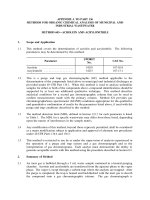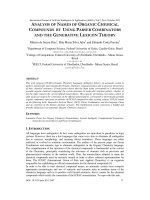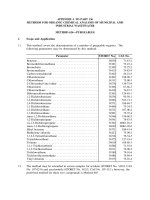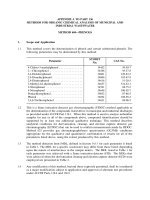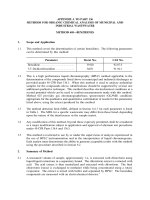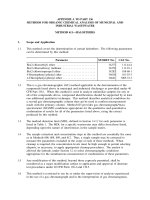Agriculture Chemical Analysis manual
Bạn đang xem bản rút gọn của tài liệu. Xem và tải ngay bản đầy đủ của tài liệu tại đây (1.36 MB, 287 trang )
M
ETHODS IN
A
GRICULTURAL
C
HEMICAL
A
NALYSIS
A Practical Handbook
To Alwyn, Antonia and Bethan
N.T. Faithfull
Institute of Rural Studies
University of Wales
Aberystwyth
UK
CABI Publishing
M
ETHODS IN
A
GRICULTURAL
C
HEMICAL
A
NALYSIS
A Practical Handbook
CABI Publishing is a division of CAB International
CABI Publishing CABI Publishing
CAB International 10 E 40th Street
Wallingford Suite 3203
Oxon OX10 8DE New York, NY 10016
UK USA
Tel: +44 (0)1491 832111 Tel: +1 212 481 7018
Fax: +44 (0)1491 833508 Fax: +1 212 686 7993
E-mail: E-mail:
Web site: www.cabi-publishing.org
©CAB International 2002. All rights reserved. No part of this publication may
be reproduced in any form or by any means, electronically, mechanically, by
photocopying, recording or otherwise, without the prior permission of the copy-
right owners.
A catalogue record for this book is available from the British Library, London,
UK.
Library of Congress Cataloging-in-Publication Data
Faithfull, N.T. (Nigel T.)
Methods in agricultural chemical analysis: a practical handbook / N.T. Faithfull.
p. cm.
Includes bibliographical references (p. 206).
ISBN 0–85199–608–6
1. Soils Analysis Handbooks, manuals, etc. 2. Plants Analysis Hand-books,
manuals, etc. 3. Chemistry, Analytic Handbooks, manuals, etc. I. Title.
S593 .F19 2002
630’.2’43 dc21
2002005768
ISBN 0 85199 608 6
Typeset by Wyvern 21 Ltd, Bristol
Printed and bound in the UK by Biddles Ltd, Guildford and King’s Lynn
Preface xii
About the Author xv
Disclaimer xvi
Acknowledgements xvii
Abbreviations and Acronyms xx
Chapter 1 Experimental Planning 1
Experimental Design 1
Plot size 2
Equipment Considerations 2
Autoanalysis 2
Samplers 4
Peristaltic pumps 4
Chemistry module 5
Heating bath and dialyser 5
Colorimeter and spectrophotometer 6
Chart-recorders 6
Chart reader 7
Flow injection 8
Batch Size 8
Sampling Protocol 9
Soils 9
Composts 10
Feeds 10
Contents
v
Plant components 15
Microbiological analysis 16
Biological substances 16
Fertilizers 16
Chapter 2 Sample Preparation 17
Pre-treatment of Samples and Sample Contamination 17
Trace Element Analysis 17
Sub-sampling 18
Drying Techniques 19
Air-drying 19
Oven-drying 19
Vacuum oven 19
Freeze-drying 20
Desiccation 22
Milling, Grinding and Homogenization 22
Freezer mill 23
Homogenization 23
Storage of milled samples 24
Chapter 3 Weighing and Dispensing
Weighing Errors 26
Corrections of weighings in vacuo 26
Incorrect calibration of the balance 26
Static charge 27
Convection currents 27
Absorption of moisture by the sample 27
Absorption of moisture by the sample container 27
Dispensing Errors 28
Bottle top dispensers 28
Syringe pipettes 29
Chapter 4 Acid-digestion, Ashing and Extraction Procedures 30
Acid-digestion and Washing 30
Acid-digestion of soils 30
Total soil nitrogen 31
Acid-digestion of plant materials 32
Digestion systems 32
Distillation systems 32
Microwave acid-digestion 34
Dry ashing 35
Extraction Procedures – Plant-based Materials 36
Oils, fats and waxes 37
Fibre, lignin, cellulose, nitrogen-free extract and starch 38
In vitro digestibility 42
Nitrate and water-soluble carbohydrate 48
Water content in silage 50
vi Contents
Extraction Procedures – Soils 50
pH extractants 51
Phosphate extractants 52
Potassium extractants 54
Trace element extractants 54
Chapter 5 Analysis of Soil and Compost 57
Soil Analytical Procedures 57
Method 5.1. Determination of extractable boron 57
Method 5.2. Cation exchange capacity, exchangeable bases and
base saturation 59
Method 5.3. Determination of effective cation exchange
capacity (ECEC) 66
Method 5.4. Determination of fulvic and humic acids 68
Discussion 5.5. Determination of available nitrogen 71
Method 5.5a. Determination of nitrate by selective ion electrode 71
Discussion 5.5b. Determination of total mineralized nitrogen 72
Method 5.5b.i. Determination of extractable ammonium-N 73
Method 5.5b.ii. Determination of extractable nitrate-N 74
Discussion 5.6. Determination of organic plus ammonium nitrogen 74
Method 5.6a. Determination of soil nitrogen by autoanalysis 75
Method 5.6a.i. Reduction of nitrate before digestion and
colorimetric analysis 75
Method 5.6b. Determination of organic plus ammonium-N by
digestion and distillation 76
Discussion 5.7. Determination of soil organic matter 78
Method 5.7a. Determination of soil organic matter by loss on
ignition 78
Method 5.7b. Determination of easily oxidizable organic C by
Tinsley’s wet combustion 79
Discussion 5.8. Determination of pH and lime requirement 81
Method 5.8a. Measurement of pH 82
Method 5.8b. Determination of lime requirement 82
Method 5.8c. Determination of pH in soils with soluble salts 83
Discussion 5.9. Determination of extractable phosphorus 84
Method 5.9a. Determination of extractable phosphorus (manual
method) 84
Method 5.9b. Determination of extractable phosphorus
(automated method) 86
Method 5.9c. Determination of resin extractable phosphorus
(automated method) 87
Method 5.10. Determination of extractable magnesium, potassium
and sodium 89
Method 5.11. Determination of extractable trace elements 91
Discussion 5.12. Determination of extractable sulphur 93
Method 5.12a. Determination of extractable sulphur (manual
method) 94
Contents vii
Method 5.12b. Determination of extractable sulphur (automated
method) 96
The Analysis of Composts
Method 5.13. Determination of CEC in composts 101
Method 5.14. Determination of Ca, K, Mg and P in composts 103
Method 5.15. Determination of heavy metals in compost 104
Chapter 6 The Analysis of Fertilizers 106
Fertilizer Analytical Procedures 107
Discussion 6.1. Determination of total nitrogen in presence of
nitrate and organic N 107
Method 6.1a. Determination of total nitrogen in presence of
nitrate and organic N, with final determination by distillation 108
Method 6.1b. Determination of total nitrogen in presence of
nitrate and organic N, with final determination by autoanalysis 109
Discussion 6.2. Determination of phosphorus in fertilizers 110
Method 6.2a. Determination of water-soluble phosphorus
(extraction) 114
Method 6.2a.i. Determination of water-soluble phosphorus
(autoanalysis) 114
Method 6.2a.ii. Determination of water-soluble phosphorus
(manual method) 116
Method 6.2b. Determination of 2% citric acid-soluble phosphorus
– method for basic slags (Thomas phosphate) 117
Method 6.2c. Determination of total phosphorus in the acid
digest from Method 6.1b. with final determination by autoanalysis 118
Discussion 6.3 Determination of potassium in fertilizers 119
Method 6.3a. Determination of water-soluble potassium 120
Method 6.3b. Determination of ammonium oxalate-soluble
potassium 120
Method 6.3c. Determination of potassium in the acid digest from
Methods 6.1a. or 6.1b 121
Liming Materials 121
Method 6.4. Determination of the moisture and neutralizing
value of liming materials 122
Method 6.5. Determination of fineness of grinding (150 µm/100
mesh fraction) 123
Chapter 7 The Analysis of Animal Feed and Plant Materials 124
Discussion 7.1. Determination of acid detergent fibre, cellulose
and lignin 125
Method 7.1a. Determination of acid detergent fibre 125
Method 7.1b. Determination of lignin 126
Method 7.1c. Determination of cellulose and ash 127
Method 7.2. Determination of crude fibre 128
Method 7.3. Determination of modified acid detergent fibre (MAD
fibre) 130
viii Contents
Method 7.4. Determination of neutral cellulase plus gamanase
digestibility (NCGD) of feeding stuffs 131
Method 7.5. Determination of neutral detergent fibre (NDF) or plant
cell-wall constituents 133
Method 7.6. Determination of nitrate in plant material by
autoanalysis 135
Discussion 7.7. Determination of total nitrogen (crude protein) in
plant material and feeding stuffs 137
Method 7.7a. Determination of total nitrogen (crude protein) in
plant material by autoanalysis 138
Discussion 7.8. Determination of oil in feeding stuffs by extraction
with petroleum spirit 141
Method 7.8a. Determination of oil in feeding stuffs by extraction
with petroleum spirit 142
Method 7.8b. Determination of oil in rapeseed 142
Method 7.9. Determination of pepsin–cellulase digestibility of plant
material 143
Discussion 7.10. Determination of total phosphorus in plant
material and feeding stuffs 144
Method 7.10a. Determination of total phosphorus in plant material
by autoanalysis 145
Discussion 7.11. Determination of total potassium in plant material
and feeding stuffs 146
Method 7.11a. Preparation of plant sample solution by dry
combustion 147
Method 7.11b. Determination of potassium in plant material by
flame photometry (dry ashing extract) 148
Method 7.11c. Determination of potassium in plant material by
flame photometry (Kjeldahl acid digest) 148
Discussion 7.12. Determination of starch by acid
hydrolysis 149
Method 7.12a. Determination of starch in potatoes by hydrolysis
and autoanalysis 149
Discussion 7.13. Determination of trace elements in
plants and feeds 150
Method 7.13a. Determination of trace elements in plants and feeds 151
Method 7.14. Determination of water soluble carbohydrate by
autoanalysis 151
Chapter 8 The Analysis of Silage 154
Method 8.1. Determination of ammonium-N in silage 154
Method 8.2. Determination of moisture in silage 156
Method 8.3. Determination of pH in silage 159
Discussion 8.4. Determination of volatile fatty acids (VFAs)
in silage 159
Method 8.4. Extraction method for obtaining silage juice for
analysis for VFAs 164
Contents ix
Chapter 9 Near Infrared Spectroscopy 167
Prediction of Metabolizable Energy (ME) 167
Applications of NIR 168
Interpreting NIR Spectra 169
Interferences 170
Chapter 10 Methods in Equine Nutrition 172
Toxic Effects of Some Elements 172
Method 10.1a. Application of ytterbium marker to feed 175
Method 10.1b. Feeding of ytterbium marked feed and faecal
collection and preparation 176
Method 10.1c. Preparation of ytterbium marked feed for analysis 177
Mobile Bag Technique (MBT) 177
Method 10.2. Determination of digestibility using the mobile
bag technique 179
Hemicellulose 181
Non-starch polysaccharides (NSP) 182
Method 10.3. Determination of total non-starch polysaccharides 183
Chapter 11 Methods for Organic Farmers and Growers 187
Origins 187
Balance 188
Albrecht 189
Basic cation saturation ratio 189
Other ratios 190
N:K balance 190
Trace elements 190
Fertilizers 191
Commercial Analytical Services 191
BCSR versus SLAN 192
Phosphate Analysis 193
Organic phosphorus 193
Determination of organic P 194
Method 11.1. Determination of extractable organic and inorganic
soil P 194
The Balzer Methods 196
pH determination 197
Humus 197
Humification (see also Chapter 5, Method 5.4) 198
Phosphorus, potassium and magnesium 198
Trace elements 199
The UK Situation 199
Chapter 12 Quality Assurance and Control 200
Replicates 201
Standard Reference Materials 202
Quality Systems 203
x Contents
Matrix Interference 204
Standard Additions, or ‘Spiking’ 204
References 206
Appendix 1: Equipment Suppliers 223
Appendix 2: Soil Index Table 225
Appendix 3: Lime Application Rates for Arable Land 226
Appendix 4: Lime Application Rates for Grassland 227
Appendix 5: Nitrate and Nitrite in Soil, Plant and Fertilizer Extracts 228
Appendix 6: Phosphate in Soil, Plant and Fertilizer Extracts 233
Appendix 7: Analytical Methods Used by ADAS for the Analysis
of Organic Manures 241
Appendix 8: Laboratory Safety 247
Appendix 9: Chemical Composition Data Sources for Plants, Feeds,
Blood, Urine and Soils 251
Appendix 10: Atomic Weights, Units and Conversion Tables 253
Subject Index 259
Commercial Index 265
Contents xi
The need for this publication has arisen in four ways. The first is that rela-
tively few staff engaged in agricultural research in educational institutions
have sufficient knowledge of chemistry to make informed decisions regard-
ing choice of the most suitable analytical method for their purposes. For exam-
ple, an unsuitable sample drying process can destroy or seriously degrade the
component being estimated. Second, there has been a need for a book con-
taining methods of soil and crop analysis suitable for use in undergraduate
practical classes. Lecturers under pressure to carry out publishable research
and burdened with administrative duties have little time for scouring libraries
and the Web for such methods. For the benefit of those lacking much expe-
rience in laboratory experimentation, the methods are described in greater
practical detail than found in many publications. Third, the useful manual
The Analysis of Agricultural Materials, MAFF/ADAS Reference Book 427,
HMSO, 1986, is now out of print. Lastly, the growth in organic farming, and
the establishment of the Organic Farming Centre for Wales, funded by the
National Assembly for Wales and based in the University of Wales, Institute
of Rural Studies, Aberystwyth, has engendered a fresh interest in analytical
methods more suitable for sustainable agriculture, and a chapter is included
on this area of analysis.
The nature of the contents will be determined by the practicability of the
methods in undergraduate teaching, by their acceptability for research pub-
lications, and by their affordability by public sector institutions. The use of
very expensive instruments may be referred to, but not described in detail.
This background knowledge will assist the choice of whether to send samples
Preface
xii
away for analysis. The methods have not been chosen for their suitability in
legal proceedings, although references to such will be made, and where pub-
lished on the World Wide Web, the respective websites will be given. These
official methods tend to be more elaborate, longer to perform, and far more
rigorous than required in our case. The use of the web is growing apace, and
website addresses will often be inserted in the text to aid further research.
There is no attempt to include every possible procedure, but to provide the
most useful selection.
It is anticipated that another author will publish a volume concentrating
on chemical analysis dealing with ruminant animal nutrition. To avoid dupli-
cation, this volume will not cover that area in depth.
Soils and composts
Analyses will be those in common use for soils from fields for both grass and
arable crops. MAFF/ADAS (now DEFRA) methods and Index Tables are repro-
duced by permission of the Controller of Her Majesty’s Stationery Office (Ref.
20001327). Analyses for nitrogen mineralization are included. Special con-
sideration will be given to composts and recycled urban waste.
Fertilizers
It is quite common for the researcher to check the specified minerals as stat-
ed on the label. Some methods will cover the usual elements.
Plant materials
Research methods demand large numbers of samples. The only way the
throughput can be achieved is by using some form of automatic processing.
Such methods using segmented flow analysers were conceived by Skeggs
(1957) for use in clinical analysis, but found wide application in water, soil
and plant analyses in the mid-1960s. In 1968, the author established an ana-
lytical laboratory at the University of Wales, Aberystwyth, with the remit to
install this type of equipment for the analysis of plant samples from the
Departments of Agriculture, Biology and Biochemistry. Further discussion of
segmented flow analysis will be found in Chapter 1. These are the reasons
why, in addition to the well-established manual procedures such as for fibre,
automatic methods will be preferred if they exist, but references to the equiv-
alent manual methods will usually be provided if available.
Feeds
This relates closely to animal nutrition, which may in the future be published
Preface xiii
elsewhere as indicated previously. Considerations relating to grass, hay, hay-
lage, silage, compound feeds and grain will be given.
Plant components
Research samples may contain just one part of the structure of the plant: leaf,
stem, root, etc. Certain precautions may be applicable.
Biological substances
This will not be covered in depth, but some types of material may occa-
sionally be presented for analysis, so a few selected procedures and refer-
ences will be given.
Equine nutrition
In some ways this is a developing area, and certainly lags behind ruminant
nutrition in the published material. The discussion will include any details of
recent work in this field.
Microbiological analysis
This is really not chemical analysis, but some references are suggested.
xiv Preface
Nigel Faithfull spent 4 years in the laboratories of RTZ at Avonmouth before
proceeding to the University of Wales at Aberystwyth. He graduated with
Honours in Chemistry (1968), and immediately took charge of the newly
established Agricultural Sciences Analytical Laboratory. Research into auto-
mated methods in herbage analysis led to an MSc, and further studies involv-
ing atomic absorption spectrophotometry resulted in a PhD in 1975. He is a
Chartered Chemist and a Member of the Royal Society of Chemistry. He was
a member of college safety committees for about 30 years. Following a merg-
er with the Welsh Agricultural College, the Analytical Laboratory is now locat-
ed at the UWA Institute of Rural Studies, Llanbadarn Campus, Aberystwyth,
where a commercial soil analysis service for farmers has been in operation
for several years.
N.T. Faithfull, MSc PhD (Wales) CChem MRSC
Institute of Rural Studies
University of Wales
Llanbadarn Campus
Aberystwyth
Ceredigion SY23 3AL
UK
About the Author
xv
Trade names in this publication are used only to provide specific information
and to illustrate the type of equipment being discussed. Mention of a trade
name does not imply an endorsement of that product or constitute a recom-
mendation of it in preference to any other product which is not mentioned.
The purchaser of any equipment must ensure it is suitable for the purpose for
which it is intended, and compatible with any items to which it is to be con-
nected.
All methods should be carried out only by competent persons and with
adequate supervision when necessary. All obligations under The Control of
Substances Hazardous to Health Regulations 1999 (COSHH), should be
observed, and risk-assessment documentation completed. Appropriate per-
sonal protective equipment should be provided and worn whenever recom-
mended. Persons carrying out the procedures in this manual do so entirely at
their own risk, and neither the author, publishers, or anyone mentioned in,
or connected with this publication can be held in any way responsible for
any accidents no matter how caused.
Disclaimer
xvi
First, I would like to express my gratitude to the teachers, lecturers and indus-
trial scientists who have instilled a high regard for practical analytical chem-
istry, with the need for care, accuracy, and the development of a skilful and
safe technique.
There are a number of individuals who have been most helpful in my
search for information. It is difficult to remember everyone I have consulted
over a period of 18 months, and my sincere apologies for any omissions. They
include the following, with the area of advice in parentheses:
Professor W.A. Adams (soil science), University of Wales, Aberystwyth, UK
F.M. Balzer (analysis for organic farming), Labor Dr F.M. Balzer, Wetter, Germany
Zoltán Bodor (fertilizer analysis), Kemira, Finland
Joao Coutinho (soil sulphate analysis), Universidade de Trás-os Montes e Alto
Douro (UTAD), Portugal
Steve Cuttle (soil analysis for organic farming), Institute for Grassland and
Environmental Research, Aberystwyth, UK
Sue Fowler (organic farming), Institute of Rural Studies, University of Wales,
Aberystwyth, UK
Professor D.I. Givens (NIR), ADAS Nutritional Sciences Research Unit,
Stratford-upon-Avon, UK
John Hollies (soil analysis), The Potash Development Association, Laugharne,
Carmarthen, UK
D. Iorwerth Jones (cellulase digestibility)
Sue Lister (NIR), Institute for Grassland and Environmental Research,
Aberystwyth
Acknowledgements
xvii
Bob Llewelyn (organic manure analysis; ADAS analytical methods), ADAS
Laboratories, Wolverhampton, UK
Peter J. Loveland (ADAS and BCSR soil analysis approaches), Silsoe Campus,
Cranfield University, UK
Ramadan Al-Mabruk (animal nutrition) Institute of Rural Studies, University
of Wales, Aberystwyth, UK
Isabel McMann (references), Bodleian Library, Oxford, UK
Tim Meeks (information), Tennessee Valley Authority
Meriel Moore-Colyer (equine nutrition), Institute of Rural Studies, University
of Wales, Aberystwyth, UK
Cornelia Moser (reference), Landwirtschaftlicher Informationsdienst (LID),
Bern, Switzerland
Suzanne Padel (organic farming), Institute of Rural Studies, University of
Wales, Aberystwyth, UK
Dan Powell (organic farming), Aberystwyth, UK
David Rowell (soil analysis), Department of Soil Science, University of
Reading, UK
Mustapha Bello Salawu (digestibility spreadsheets; silage VFA analysis),
Institute of Rural Studies, University of Wales, Aberystwyth; now at
Commonwork Group Ltd, Kent, UK
Steve Smith (reference), Stapledon Library, Institute for Grassland and
Environmental Research, Aberystwyth, UK
Stuart Smith (autoanalysis methodology), Divisional Manager, BL-Analytics,
Bran+Luebbe, UK
Rebecca Stubbs (editorial support), CABI Publishing, Wallingford, UK
Claudine Tayot (reference), OPOCE online helpdesk
Paul Thomas (NSP methodology), Institute for Grassland and Environmental
Research, Aberystwyth, UK
Ann Vaughan (lab techniques), Institute of Rural Studies, University of Wales,
Aberystwyth, UK
Joanne Vessey (fertilizer analysis), Hydro Agri (UK) Limited, Immingham Dock,
UK
Keith Way (NCGD method), Laboratory Consultant
Gabriele Weigmann-Dramé (reference), VDLUFA-Verlag, Darmstadt,
Germany
Lorraine Whyberd (information), Royal Society of Chemistry, London, UK
David Wilman (Fig. 1.5; agronomy), Institute of Rural Studies, University of
Wales, Aberystwyth, UK
I appreciate the efforts of the staff of the Huw Owen and Thomas Parry
Libraries, University of Wales, Aberystwyth, for retrieving large old tomes from
the store in an attempt to trace the origins of some methods. I am also grate-
ful to the university for permission to use the facilities of the Information
Services subsequent to taking early ‘retirement’.
I would like to thank ADAS, Wolverhampton, for permission to repro-
duce the information in Appendix 7; Bran+Luebbe, for permission to repro-
duce the methods in Appendices 5 and 6; and the Controller of Her Majesty’s
xviii Acknowledgements
Stationery Office for a licence to reproduce material from the MAFF/ADAS
publications: The Analysis of Agricultural Materials Reference Book 427, and
Fertiliser Recommendations Reference book 209 5th and 6th edns.
Finally, many thanks to my wife Eileen, for her continuous support,
patience and encouragement throughout this task.
Acknowledgements xix
AA atomic absorption
AAS atomic absorption spectrophotometry
ac alternating current
ADAS Agricultural Development and Advisory Service
(UK)
ADF acid detergent fibre
AES atomic emission spectrometry
AOAC Association of Official Analytical Chemists
BCSR basic cation saturation ratio
CEC cation exchange capacity
cmol
c
centimole charge
COSHH Control of Substances Hazardous to Health
Regulations (1999)
CP crude protein
CRM Certified Reference Material
CSL Central Science Laboratory
DEFRA Department for Environment, Food and Rural
Affairs (UK)
detn determination
DM dry matter
DMD dry matter digestibility
DMSO dimethylsulphoxide
DOMD digestible organic matter in dry matter
Abbreviations and Acronyms
xx
DTPA diethylenetriaminepentaacetic acid, or
diethylenetrinitrilopentaacetic acid
ECEC effective cation exchange capacity
ED effective degradability
EDTA diaminoethanetetraacetic acid,
ethylenediaminetetraacetic acid, or
(ethylenedinitrilo)tetraacetic acid
EPA Environmental Protection Agency (US)
FAPAS Food Analysis Performance Assessment Scheme
FEPAS Food Examination Performance Assessment
Scheme
FIA flow-injection analysis
FP flame photometry
GC gas chromatography
GLC gas–liquid chromatography
GLP Good Laboratory Practice
HDPE high density polyethylene
HPLC high-performance liquid chromatography
HS humic substances
HSE The Health and Safety Executive (UK)
ICP inductively coupled plasma emission
spectroscopy
ICP-MS hyphenated technique of ICP followed
immediately by MS
ICP-OES inductively coupled plasma optical emission
spectroscopy
ID inside diameter
IGER Institute for Grassland and Environmental
Research
IMS industrial methylated spirits
IR infrared
ISE ion-selective electrode
ISO International Organization for Standardization
IV in vitro
IVDMD in vitro dry matter digestibility
LGC Laboratory of the Government Chemist
m mass (when used in % m/m)
MADF modified acid detergent fibre
MAFF (now DEFRA) Ministry of Agriculture, Fisheries and Food (UK)
MBT mobile bag technique
ME metabolizable energy
mol molecular weight in grams (relative molecular
mass)
MS mass spectrometry
NAMAS National Measurement Accreditation Service
(now FAPAS)
Abbreviations xxi
NCGD neutral cellulase plus gamanase digestibility
NDF neutral detergent fibre
NIR; NIRS near infrared, or near infrared reflectance
spectroscopy
NIST National Institute of Standards and Technology
NMR nuclear magnetic resonance
NSP non-starch polysaccharide
NVLAP National Voluntary Laboratory Accreditation
Program
OD outside diameter
OECD Organisation for Economic Co-operation and
Development
OEM original equipment manufacturer
OMD organic matter digestibility
OSHA Occupational Safety and Health Administration
(US)
PAH polycyclic aromatic hydrocarbon(s)
PPE personal protective equipment
PTFE polytetrafluoroethane
PVC polyvinyl chloride
RI refractive index
rpm revolutions per minute
RPRs reactive phosphate rocks
SGS Société Générale de Surveillance
SI Statutory Instrument
SLAN sufficiency level of available nutrient
SNV-D standard normal variate and detrend
SOC soil organic carbon
TCA The Composting Association
TEA triethanolamine
TEB total exchangeable bases
TOM total organic matter
t.p.i. threads per inch
UKAS United Kingdom Accreditation Service
UKASTA United Kingdom Agricultural Supply Trade
Association
URL Uniform Resource Locator (Internet website
address)
USDA United States Department of Agriculture
UV ultraviolet
v volume
VAM valid analytical measurement
VFA volatile fatty acid
WPBS Welsh Plant Breeding Station (now Institute for
Grassland and Environmental Research)
WSC water soluble carbohydrate
xxii Abbreviations
Experimental Design
Experimental design is not directly related to chemical analysis, but it is impor-
tant in that it determines the number of samples for processing. This could
mean that there are too many tests for the laboratory to fit into its schedule,
bearing in mind that there are many other customers clamouring for labora-
tory services. It could also mean that the cost is prohibitive for the funds avail-
able for the project.
Some of the books on the design of scientific experiments appear far too
theoretical for use in college field trials. However, three books in particular
have proved useful in this Institute:
• Statistical Procedures for Agricultural Research, 2nd edn. Gomez, K.A. and
Gomez, A.A. John Wiley & Sons, 1984.
• Agricultural Experimentation. Little, T.M. and Hills, F.J. John Wiley & Sons,
1978.
• Statistical Methods in Agriculture and Biology, 2nd edn. Mead, R., Curnow,
R.N. and Hasted, A.M. Chapman and Hall, 1993.
For example, the book by Gomez and Gomez describes many possible
designs such as the Latin square and the lattice designs. The former can handle
simultaneously two known sources of variation among experimental units.
Chapters deal with ‘Sampling in experimental plots’, and the ‘Presentation of
research results’.
1
© 2002 CAB International. Methods in Agricultural Chemical Analysis: a Practical
Handbook (N.T. Faithfull)
1 Experimental Planning
Plot size
The field plot size is chosen to give the required degree of precision for
measurement of the selected characteristic. Sampling only a fraction of the
plot, providing the sampling error is acceptable, may save time and expense.
The sampling error is the difference between the value of the fraction and the
value if the whole plot (population) had been sampled. If adequate precision
is retained, it may be possible to bulk samples together at a later stage to
reduce the numbers for chemical analysis.
Equipment Considerations
Autoanalysis
There is usually no problem of access to basic laboratory instruments and
associated glassware, however, the only means of handling large numbers of
tests is to apply some form of automation. An added advantage is that it
improves the analytical precision and reproducibility. The most suitable tech-
nique has been based on the segmented continuous-flow principle invented
by Skeggs (1957), and which was first marketed as the Technicon
®
AutoAnalyzer. The system consists of a number of modules powered from a
stabilized 110 V supply, and a typical layout is shown in Fig. 1.1.
This was improved with the next generation AutoAnalyzer II, which pro-
vided the peristaltic pump with a metering air-bar. This aided a more regular
bubble pattern with further improvement in precision. The current
AutoAnalyzer 3 system offers several useful features. The Compact Sampler
has random access, which means that if there is an over-range sample, which
may distort the succeeding two peaks, the software will automatically
instruct the sampler to repeat the affected peaks. This system saves a lot of
time because the operator does not have to work out the repeats after a long
run and reload the cups to be repeated. The pump in the current model has
the option of dilution valves that allow automatic rerun of off-scale samples
at a higher dilution. The segmented stream can pass through the colorimeter
flowcell without debubbling, the software switches off the detection signal
when a bubble is present. The redesigned flowcell has a square-edge planar
window and uses fibre optics to ensure parallel light transmission and hence
a reduction of interference from variation in refractive index of the liquid
stream.
More information can be found on the manufacturer’s website:
/>The price range for a basic system with a colorimeter is about £20k to £27k
depending on options (e.g. PC and flame photometer) and whether educa-
tional discount applies.
Other manufacturers of segmented-flow analysers are Burkard Scientific, see:
kardscientific.co.uk/Analytical/Systems_Analysers_SF
A2000.htm
2 Chapter 1


